Analysis and Optimization Design of Internal Flow Evolution of Large Centrifugal Fans Under Inlet Distortion Effects
Abstract
1. Introductory
2. Numerical Simulation and Experimental Validation
2.1. Research Object
2.2. Numerical Simulation
3. The Impeller Optimization Design Method
3.1. Theoretical Analysis
3.2. Impeller Flow Passage Cross-Section Design
4. Results and Discussion
4.1. Comparative Analysis of Internal Flow Characteristics
4.2. Comparative Analysis of Experimental Results
5. Conclusions
- (1)
- The SST k-ω turbulence model, modified with the eddy viscosity coefficient, was compared with experimental results of flow in a U-shaped pipe. The modified SST k-ω model effectively captures the non-uniform velocity distribution characteristics, with a maximum error of only 4.7%. The refined computational model improves the accuracy of the results, thereby providing a more precise analytical tool for evaluating the impact of subsequent impeller structural optimizations on performance improvements.
- (2)
- Under the influence of the complex flow channel structure within the gas quenching furnace, the airflow parameters at the fan inlet cross-section undergo distortion. The maximum swirl angle appears at the circumferential position of 60°, corresponding to downstream passage A. In this passage, the mid-span tip leakage flow along the suction side is affected by vortices, eventually mixing with them. This interaction forms a large vortex in the rear section of the passage. Additionally, a stall vortex perpendicular to the blade and spanning the entire passage develops in the downstream section, resulting in an average blockage coefficient of 0.29. At the circumferential position of 300°, where the minimum swirl angle occurs, the corresponding downstream impeller passage B exhibits strip-like leakage flow at the rear of the blade tip. However, no large-scale vortex structure is formed, and the average blockage coefficient decreases to 0.27.
- (3)
- The impeller flow passage optimization design method based on the suppression of secondary flows effectively improves the secondary flow phenomena and the intensity of tip leakage flows within the impeller. The modified impeller achieves an 11.7% increase in maximum efficiency compared to the original design, with the blockage coefficients in passages A and B reduced to 0.07 and 0.04, respectively. Additionally, flow field and temperature field experimental tests were conducted on the entire vacuum quenching furnace system. The test results show that the standard deviations of the velocity at the center of the test sections at Y = 400, Y = 600, and Y = 800 were reduced by 62.97%, 60.69%, and 57.14%, respectively, compared to the original impeller. The temperature fluctuation range at the surface measurement points was reduced by 53.09%, indicating a significant improvement in the uniformity of the flow and temperature fields.
Author Contributions
Funding
Institutional Review Board Statement
Informed Consent Statement
Data Availability Statement
Acknowledgments
Conflicts of Interest
References
- Zhao, J.; Pei, J.; Wang, W.; Gan, X. Blade redesign based on inverse design method for energy performance improvement and hydro-induced vibration suppression of a multi-stage centrifugal pump. Energy 2024, 308, 132862. [Google Scholar] [CrossRef]
- Ruiz, G.R.; Bandera, C.F. Analysis of uncertainty indices used for building envelope calibration. Appl. Energy 2017, 185, 82–94. [Google Scholar] [CrossRef]
- Wang, L.; Han, Y.G.; Chen, H.B.; Wang, N.; Fu, J.Y. Research on Energy Efficiency Status of Fans in Zhejiang Province. Appl. Mech. Mater. 2015, 737, 963–966. [Google Scholar] [CrossRef]
- Xu, Y.N.; Chen, N.; Shen, X.; Xu, L.; Pan, Z.; Pan, F. Proposal and experimental case study on building ventilating fan fault diagnosis based on cuckoo search algorithm optimized extreme learning machine. Sustain. Energy Technol. Assess. 2021, 45, 100975. [Google Scholar] [CrossRef]
- Piwowarski, M.; Jakowski, D. Areas of Fan Research—A Review of the Literature in Terms of Improving Operating Efficiency and Reducing Noise Emissions. Energies 2023, 16, 1042. [Google Scholar] [CrossRef]
- Ferrari, C.; Beccati, N.; Pedrielli, F. CFD Methodology for an Underhood Analysis towards the Optimum Fan Position in a Compact Off-Road Machine. Energies 2023, 16, 4369. [Google Scholar] [CrossRef]
- Ferrari, C.; Pinelli, M.; Spina, P.R.; Bolognin, P.; Borghi, L. Fluid Dynamic Design and Optimization of Two Stage Centrifugal Fan for Industrial Burners. In Proceedings of the ASME Turbo Expo 2011, Vancouver, BC, Canada, 6–10 June 2011; Amer Soc Mechanical Engineers: New York, NY, USA, 2012; pp. 483–490. [Google Scholar] [CrossRef]
- Zhang, Y.; Dou, H.-S. Effect of Blade Profile on the Performance of a Centrifugal Fan with Different Velocity Distribution Functions. Int. J. Fluid Mach. Syst. 2020, 13, 623–634. [Google Scholar] [CrossRef]
- Shen, Y.; Li, Y.; Wang, H.; Shen, W.; Chen, Y.; Si, H. Numerical simulation and performance optimization of the centrifugal fan in a vacuum cleaner. Mod. Phys. Lett. B 2019, 33, 1950440. [Google Scholar] [CrossRef]
- Chen, G.; Xu, W.; Zhao, J.; Zhang, H. Energy-Saving Performance of Flap-Adjustment-Based Centrifugal Fan. Energies 2018, 11, 162. [Google Scholar] [CrossRef]
- Yuan, Y.; Fang, Y.; Tang, L. Effects of non-uniform elbow inflow on the unsteady flow and energy development characteristics of a centrifugal pump. Phys. Fluids 2023, 35, 015152. [Google Scholar] [CrossRef]
- Long, Y.; Wang, D.; Yin, J.; Hu, Y.; Ran, H. Numerical investigation on the unsteady characteristics of reactor coolant pumps with non-uniform inflow. Nucl. Eng. Des. 2017, 320, 65–76. [Google Scholar] [CrossRef]
- Liu, Z.; Yang, H.; He, H.; Yu, P.; Wei, Y.; Zhang, W. Flow instability in a volute-free centrifugal fan subjected to non-axisymmetric pre-swirl flow from upstream bended inflow tube. Proc. Inst. Mech. Eng. Part A J. Power Energy 2022, 236, 689–713. [Google Scholar] [CrossRef]
- Song, G.; Li, J.; Tang, M.; Wu, Y.; Luo, Y. Experimental simulation methodology and spatial transition of complex distortion fields in a S-shaped inlet. Aerosp. Sci. Technol. 2021, 116, 106855. [Google Scholar] [CrossRef]
- Cao, P.; Wang, Y.; Kang, C.; Li, G.; Zhang, X. Investigation of the role of non-uniform suction flow in the performance of water-jet pump. Ocean Eng. 2017, 140, 258–269. [Google Scholar] [CrossRef]
- Si, Q.; Tang, Y.; Gan, X.; Li, H.; Yang, S. Parametric analysis and validation of inlet elbow and impeller of vertical pipeline pump. J. Agric. Eng. 2020, 36, 54–63+313. [Google Scholar] [CrossRef]
- Yang, W.; Kuan, B. Experimental investigation of dilute turbulent particulate flow inside a curved 90° bend. Chem. Eng. Sci. 2006, 61, 3593–3601. [Google Scholar] [CrossRef]
- Ma, H.; Dai, C.; Dong, L.; Wu, X. PIV test of internal flow field in a 90° square bend. Adv. Water Resour. Hydropower Sci. Technol. 2013, 33, 31–34+56. [Google Scholar] [CrossRef]
- Mittag, S.; Gabi, M. Experimental and numerical investigation of centrifugal pumps with asymmetric inflow conditions. J. Therm. Sci. 2015, 24, 516–525. [Google Scholar] [CrossRef]
- Luo, X.; Ye, W.; Huang, R.; Wang, Y.; Du, T.; Huang, C. Numerical investigations of the energy performance and pressure fluctuations for a waterjet pump in a non-uniform inflow. Renew. Energy 2020, 153, 1042–1052. [Google Scholar] [CrossRef]
- Song, Y.; Xu, R.; Song, Y.; Long, Y.; Yin, J.L.; Wang, D. Hydrodynamics characteristics of non-uniform inflow in reactor coolant pump based on time-resolved tomographic particle image velocimetry. Phys. Fluids 2022, 34, 125132. [Google Scholar] [CrossRef]
- Liu, Z.; Huang, G.; Chen, J.; Yu, Z. Coupling Effect between Inlet Distortion Vortex and Fan. J. Therm. Sci. 2023, 32, 1089–1104. [Google Scholar] [CrossRef]
- Zhang, H.; Li, Q.; Dong, F.; Chu, W. Mechanism of Affecting the Performance and Stability of an Axial Flow Compressor with Inlet Distortion. J. Therm. Sci. 2021, 30, 1406–1420. [Google Scholar] [CrossRef]
- Zhang, H.; Liu, L.; Liu, L. Study on the effect of non-uniform incoming flow on the internal flow and performance of CAP1400 nuclear main pump. J. Xi’an Jiaotong Univ. 2023, 57, 39–48. [Google Scholar] [CrossRef]
- Hu, S.; Zhu, L.; Zhang, M.; Tang, X.; Wang, X. Development and Prospect of Vacuum High-Pressure Gas Quenching Technology. Materials 2023, 16, 7413. [Google Scholar] [CrossRef]
- Kohne, T.; Fahlkrans, J.; Haglund, S.; Stormvinter, A.; Troell, E.; Hedström, P.; Borgenstam, A. Impact of Cooling Rate during High-Pressure Gas Quenching on Fatigue Performance of Low Pressure Carburized Gears. Metals 2022, 12, 1917. [Google Scholar] [CrossRef]
- Wang, J.; Gu, J.; Shan, X.; Hao, X.; Chen, N.; Zhang, W. Numerical simulation of high pressure gas quenching of H13 steel. J. Mech. Work. Technol. 2008, 202, 188–194. [Google Scholar] [CrossRef]
- Meng, F.; Zhu, X.; Qiu, C.; Zhang, C. Simulation study on vacuum heat treatment process of 300M steel. Heat Treat. Technol. Equip. 2023, 44, 27–31. [Google Scholar] [CrossRef]
- Yang, S.; Li, J.; Liu, D.; He, D.; Bi, X.; Gao, T. Simulation of the flow field in the temperature field of gas quenching and cooling of sintered NdFeB vacuum sintering furnaces based on Fluent. Funct. Mater. Met. 2023, 30, 113–117. [Google Scholar] [CrossRef]
- Yang, J.; Zhang, H.; Wang, Y.; Wang, J. Analysis of gas cooling process and design of cooling system for vacuum furnace. Vacuum 1999, 39–43. [Google Scholar] [CrossRef]
- Huang, H.; Sun, T.; Li, N.; Zhang, G. Sensitization of the modified SST model to the swirling and curvature for turbulent impinging jet heat transfer. Int. J. Heat Mass Transf. 2022, 182, 121980. [Google Scholar] [CrossRef]
- Arolla, S.K.; Durbin, P.A. Modeling rotation and curvature effects within scalar eddy viscosity model framework. Int. J. Heat Fluid Flow 2013, 39, 78–89. [Google Scholar] [CrossRef][Green Version]
- Monson, D.; Seegmiller, H.; Mcconnaughey, P. Comparison of experiment with calculations using curvature-correctedzero and two equation turbulence models for a two-dimensional U-duct. In Proceedings of the 21st Fluid Dynamics, Plasma Dynamics and Lasers Conference, Seattle, WA, USA, 18–20 June 1990. [Google Scholar] [CrossRef]
- Wu, C.; Pu, K.; Shi, P.; Wu, P.; Huang, B.; Wu, D. Blade redesign based on secondary flow suppression to improve the dynamic performance of a centrifugal pump. J. Sound Vib. 2023, 554, 117689. [Google Scholar] [CrossRef]
- Vo, H.D.; Tan, C.S.; Greitzer, E.M. Criteria for Spike Initiated Rotating Stall. J. Turbomach. 2008, 130, 011023. [Google Scholar] [CrossRef]
- Wang, C.; Feng, J.J.; Luo, X.Q.; Lu, J.L.; Zhu, G.J. Numerical prediction of rotating stallin a low-specific speed centrifugal pump. In IOP Conference Series: Earth and Environmental Science, Proceedings of the Asian Working Group- IAHR’s Symposium on Hydraulic Machinery and Systems, Beijing, China, 16–19 November 2017; IOP Publishing Ltd.: Bristol, UK, 2018; Volume 163, p. 012091. [Google Scholar] [CrossRef]
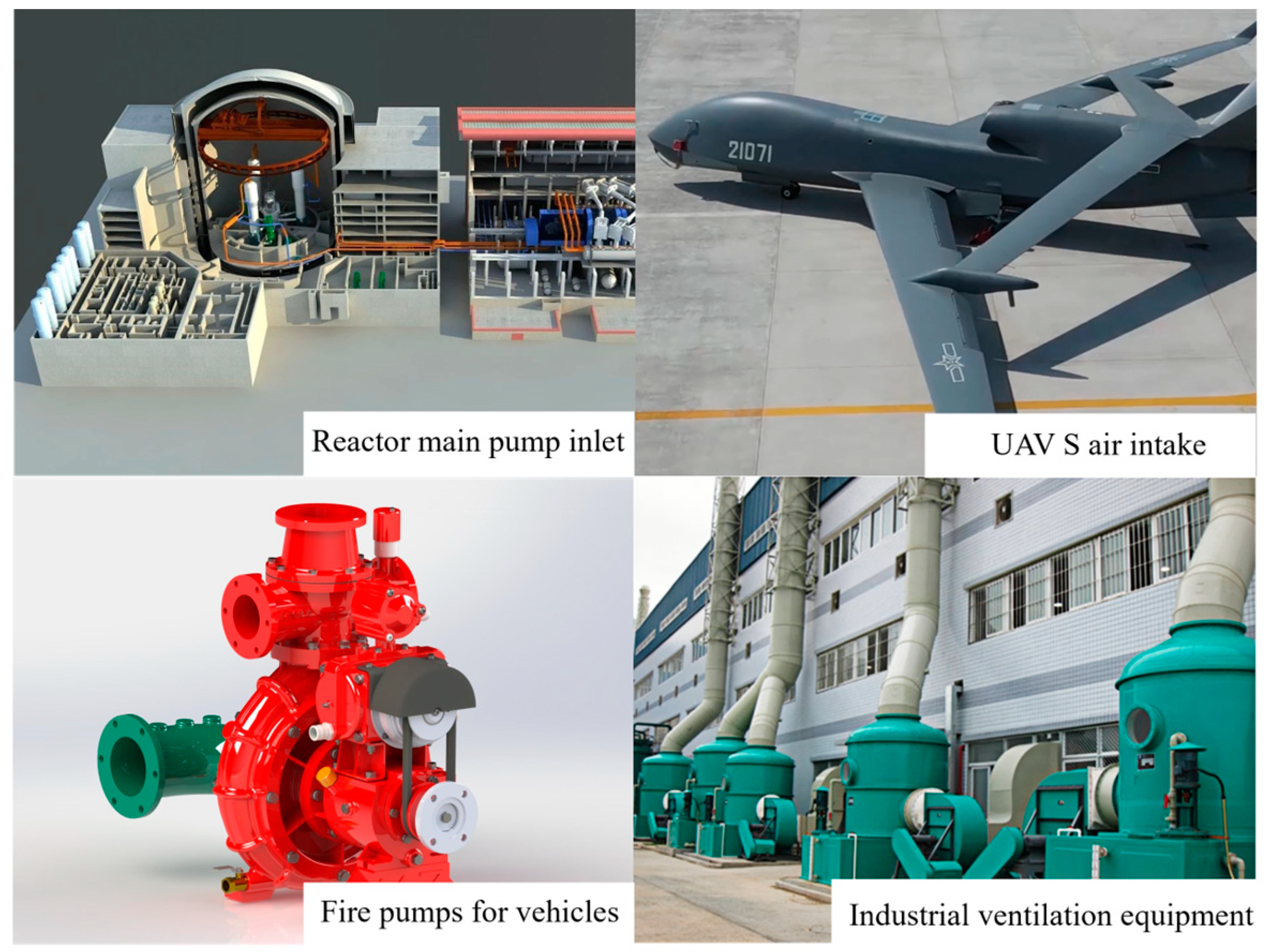




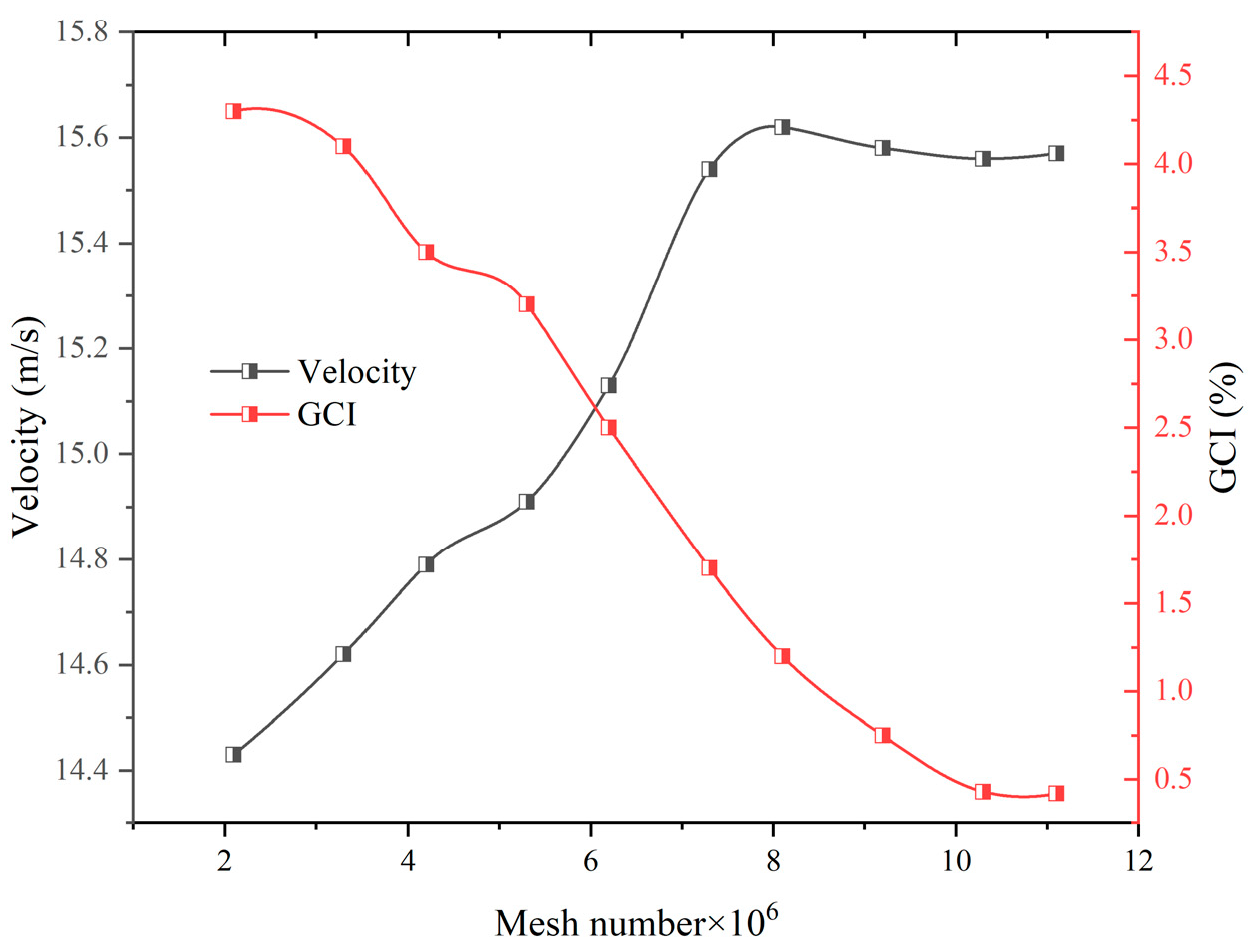
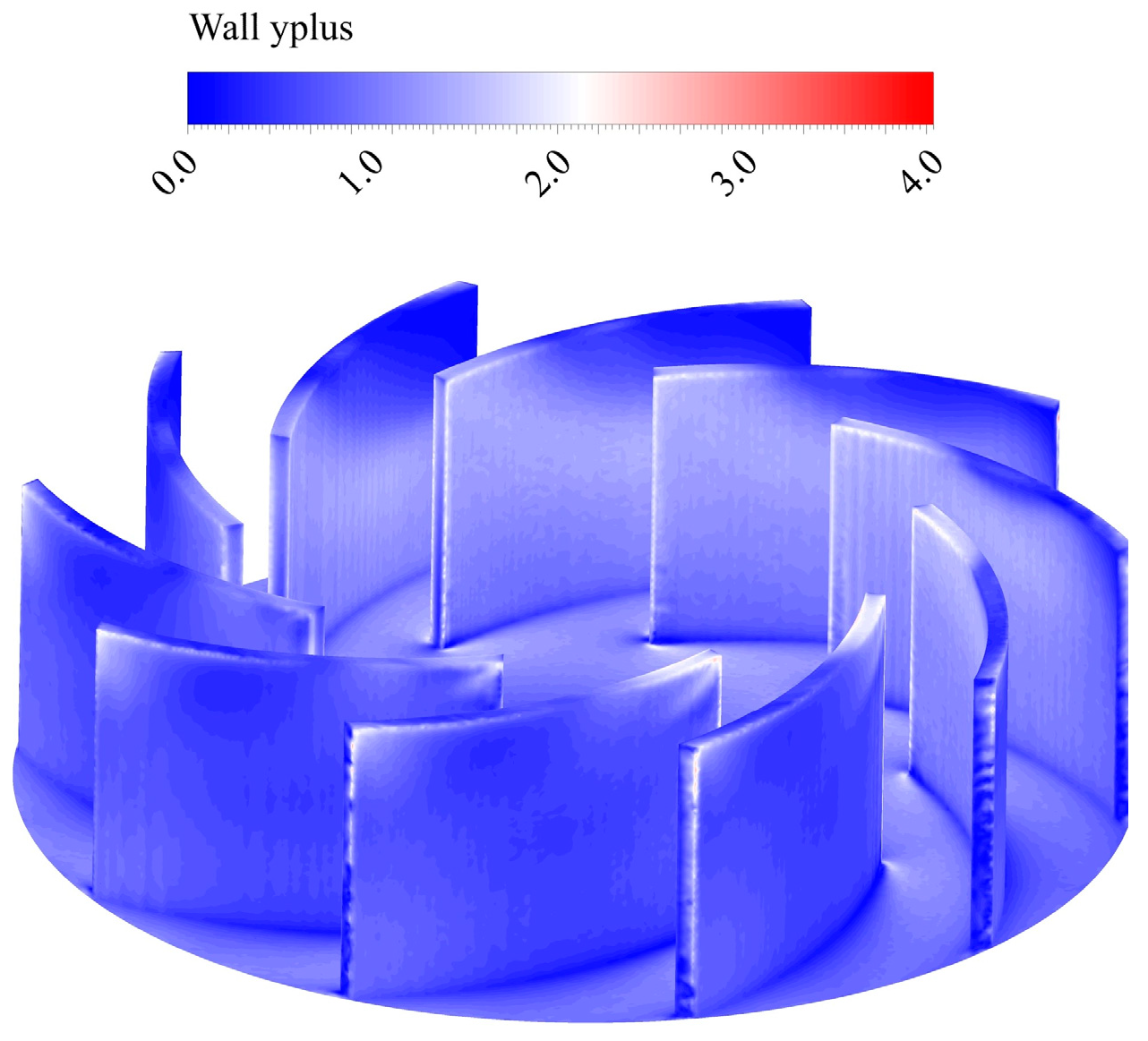


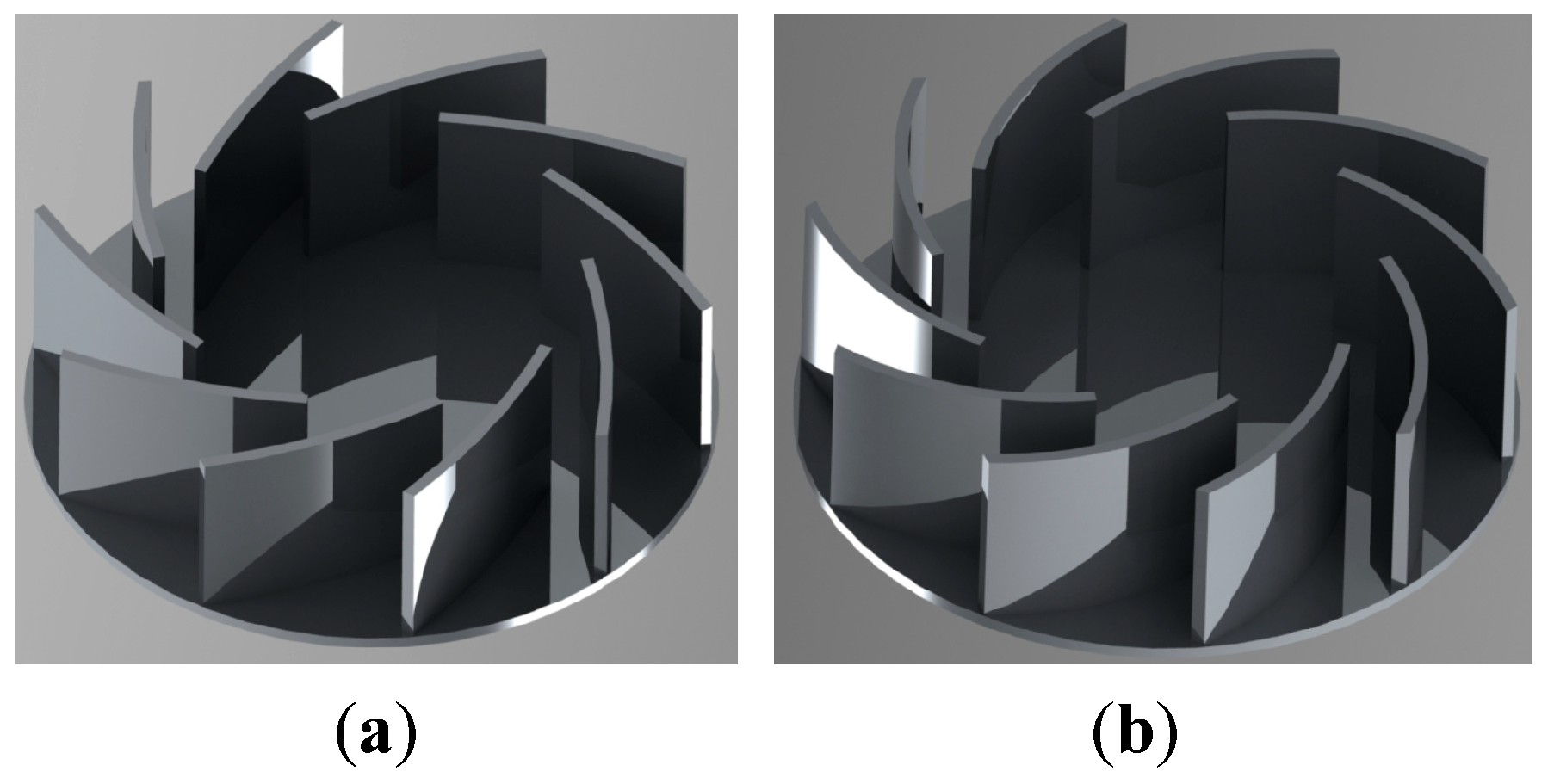
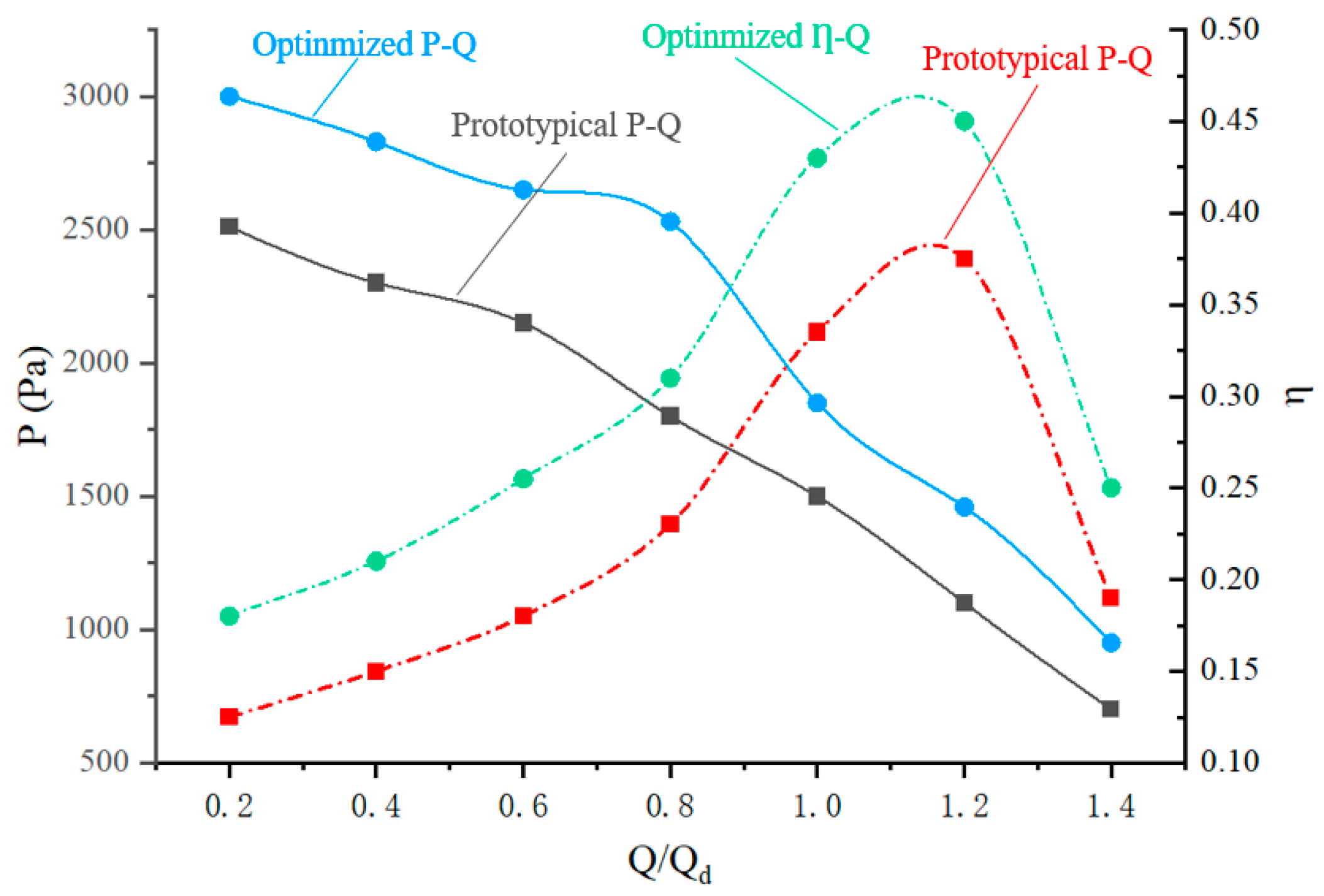
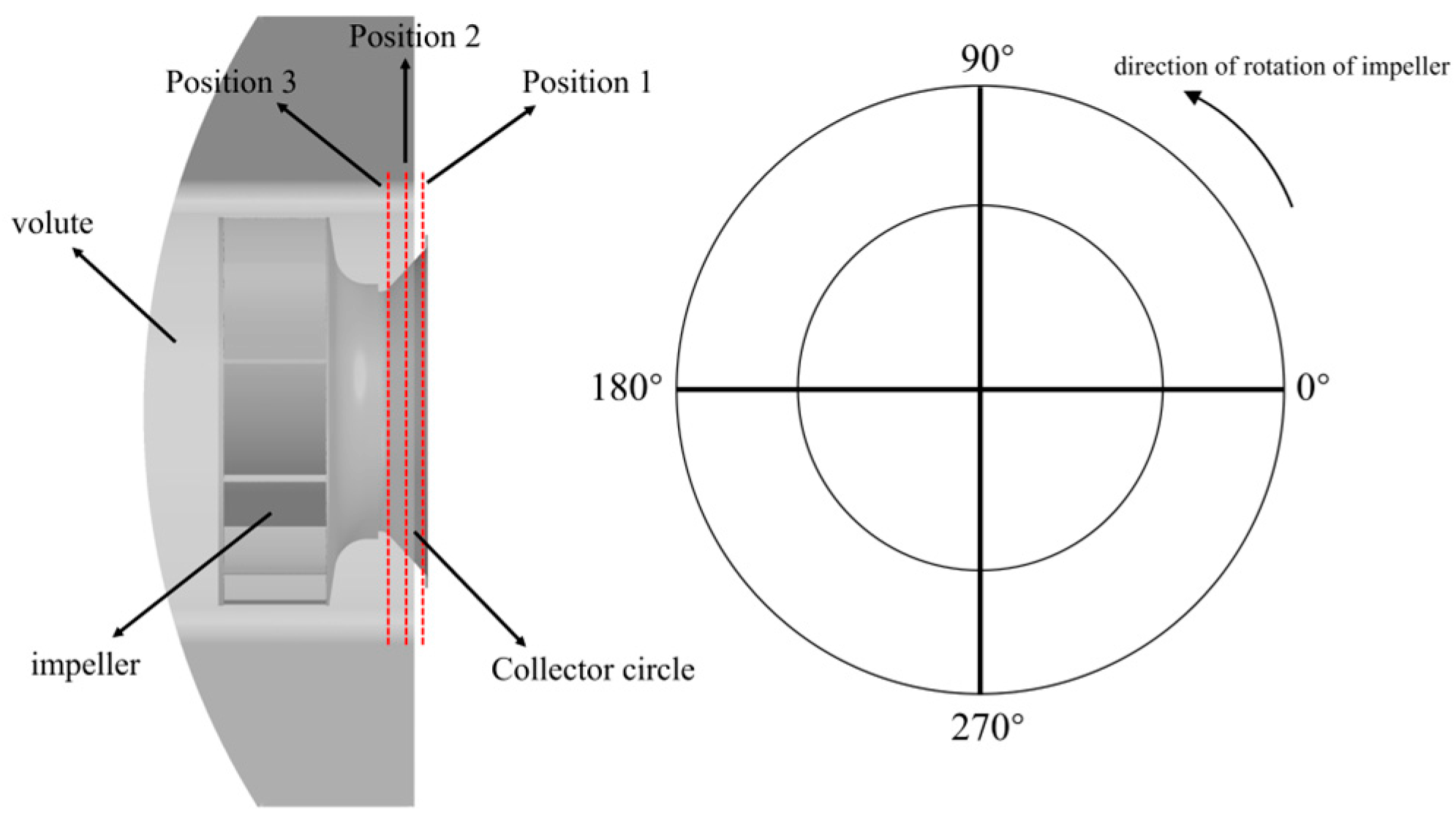
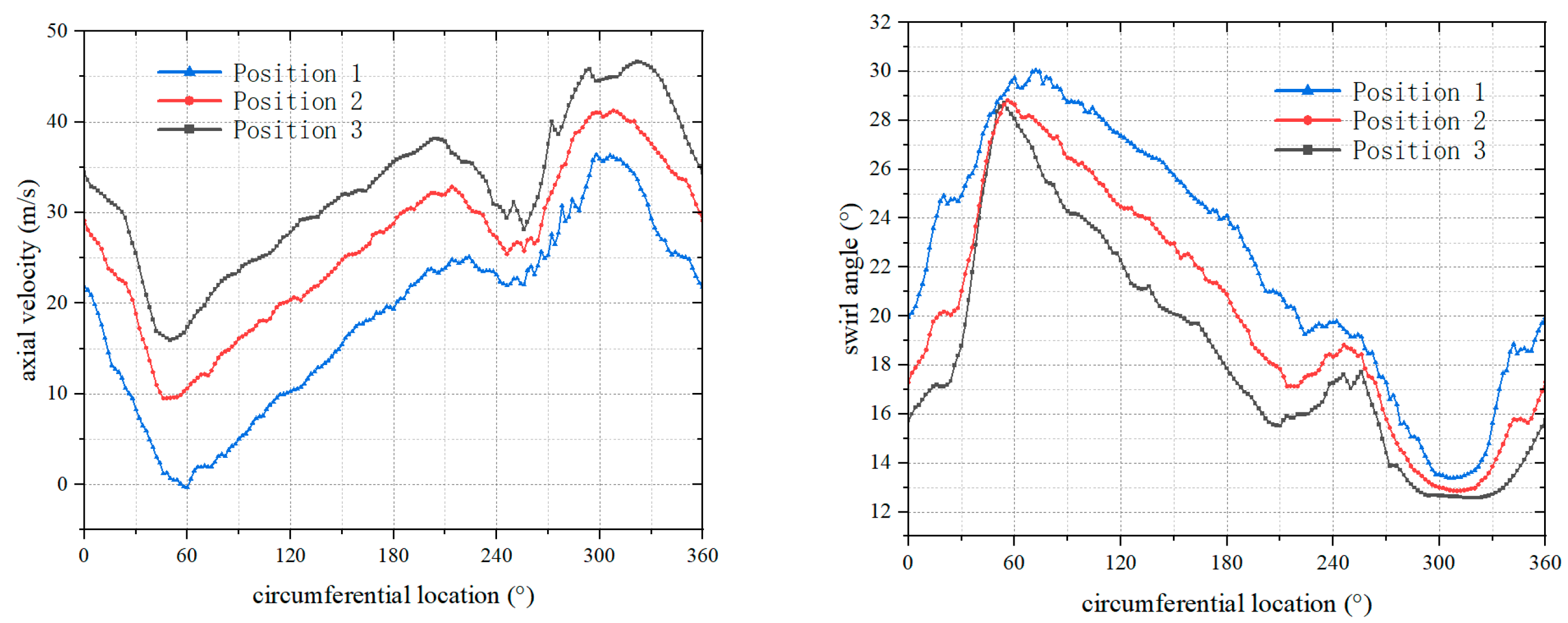

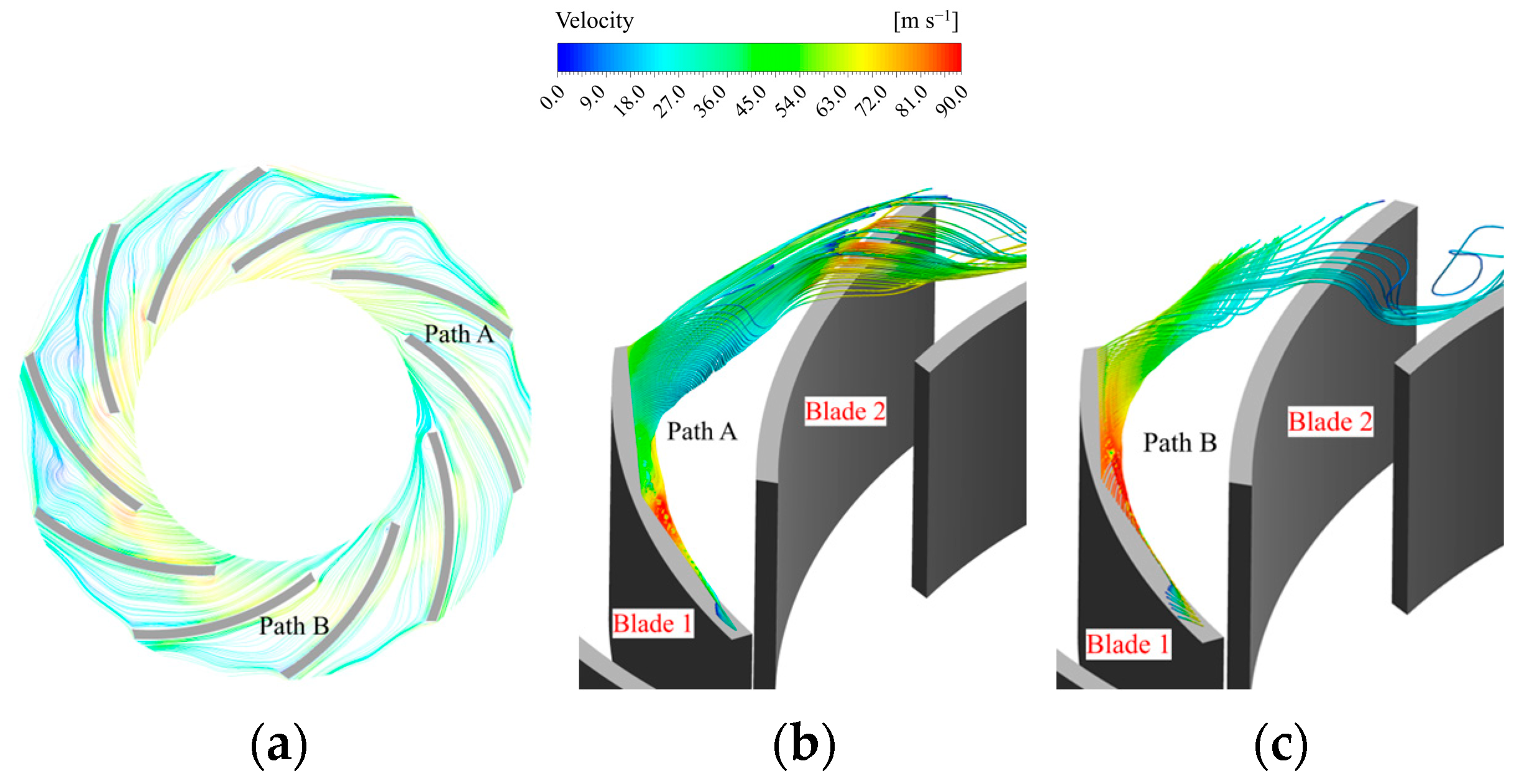
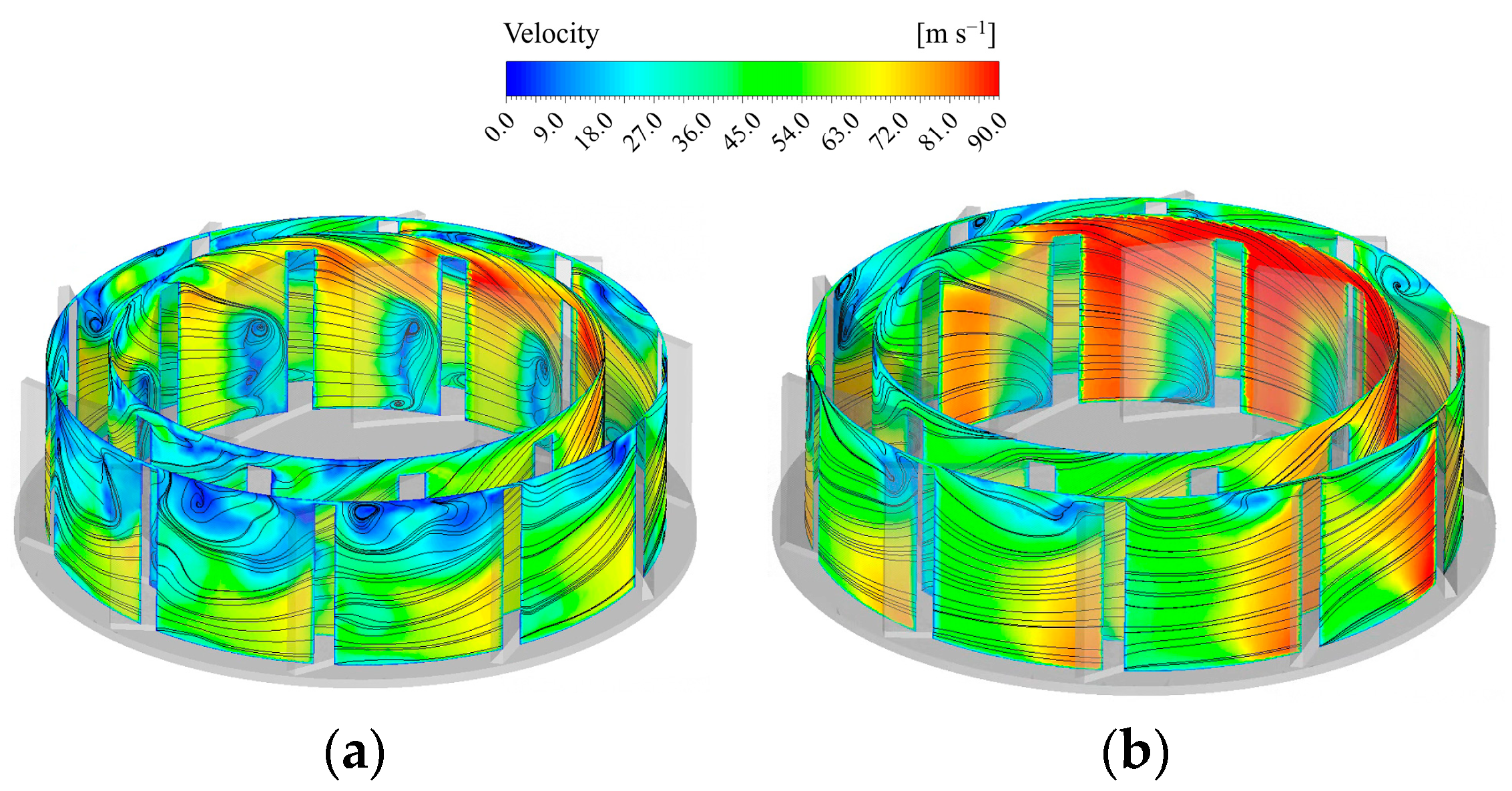
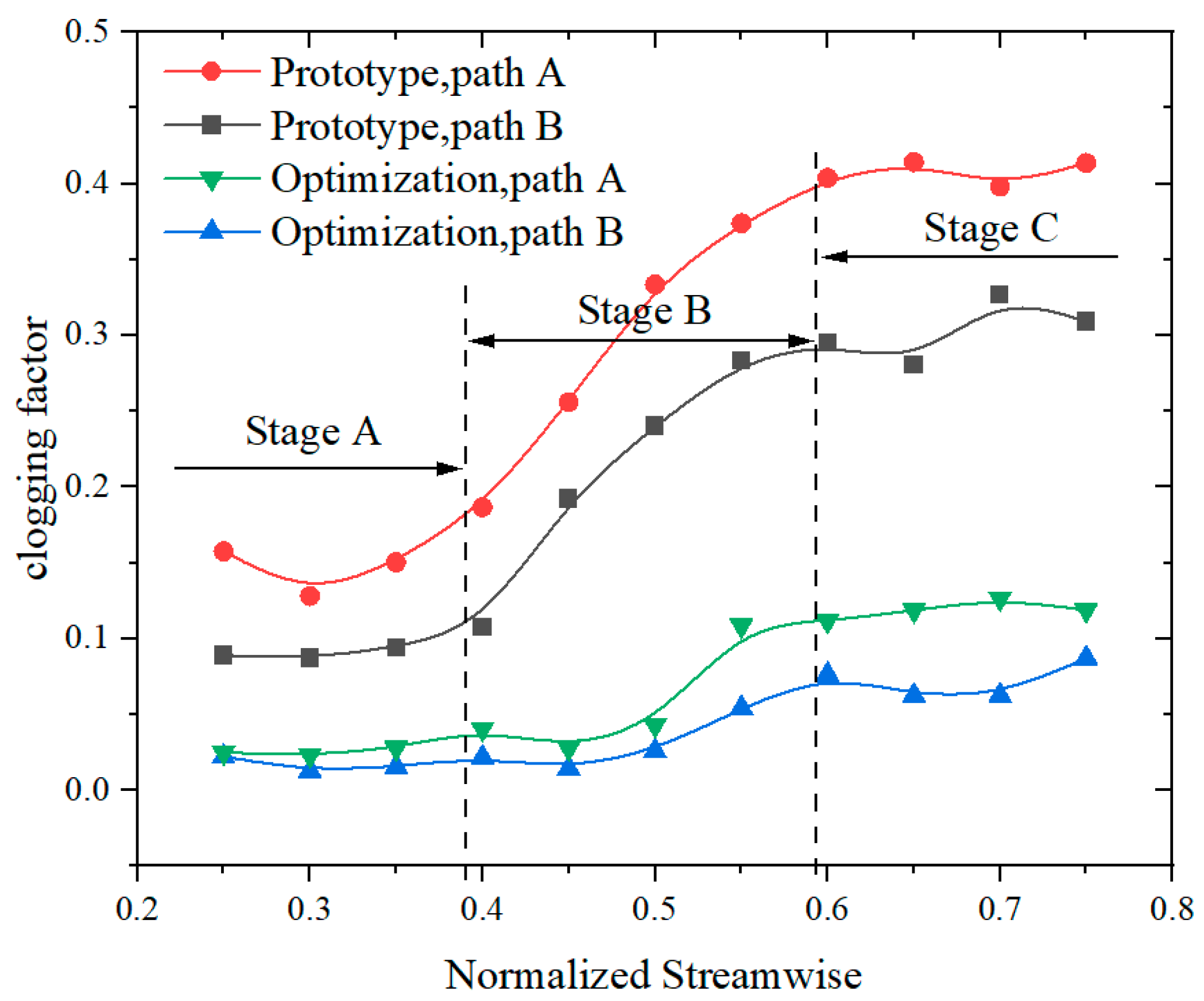
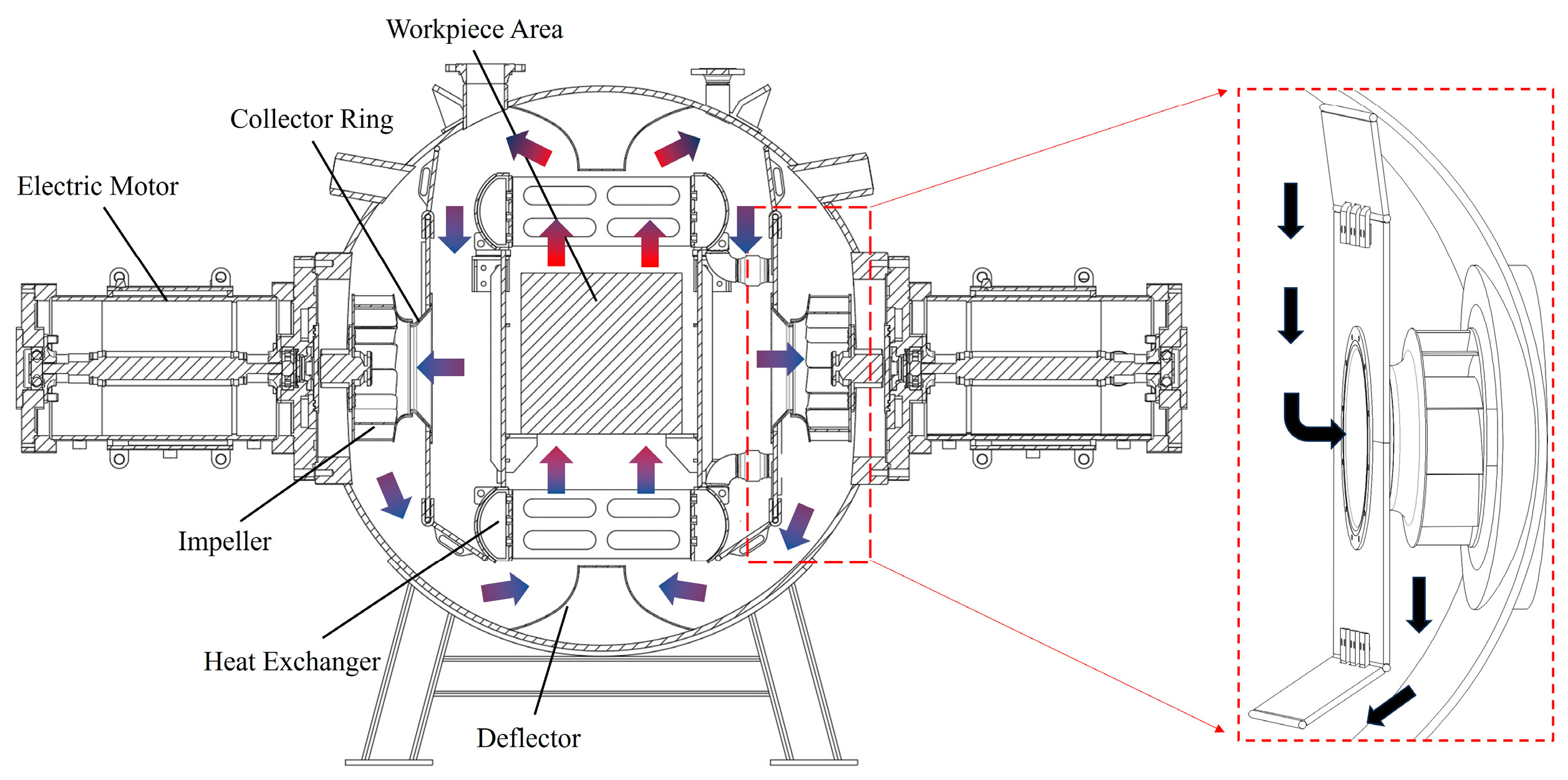
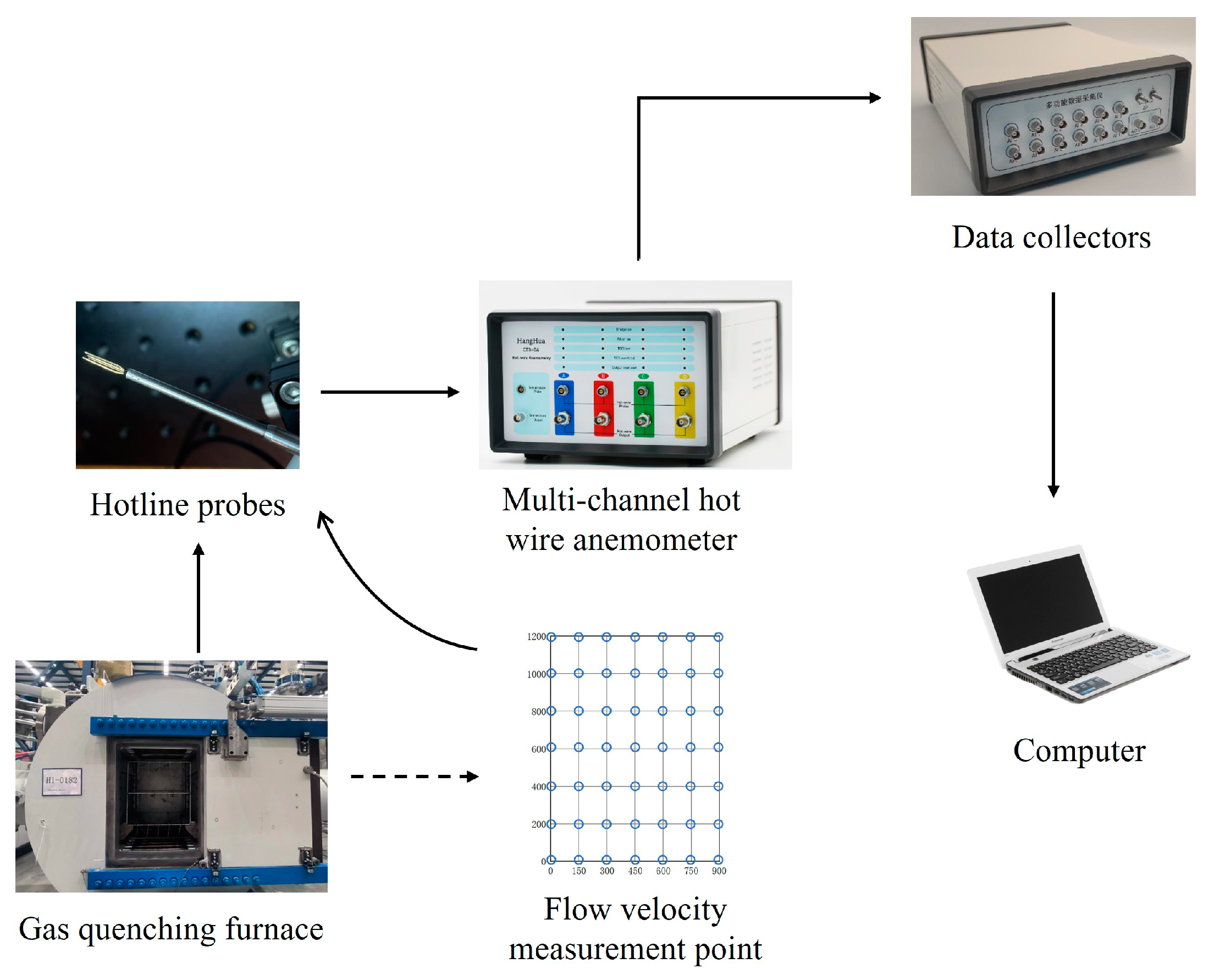
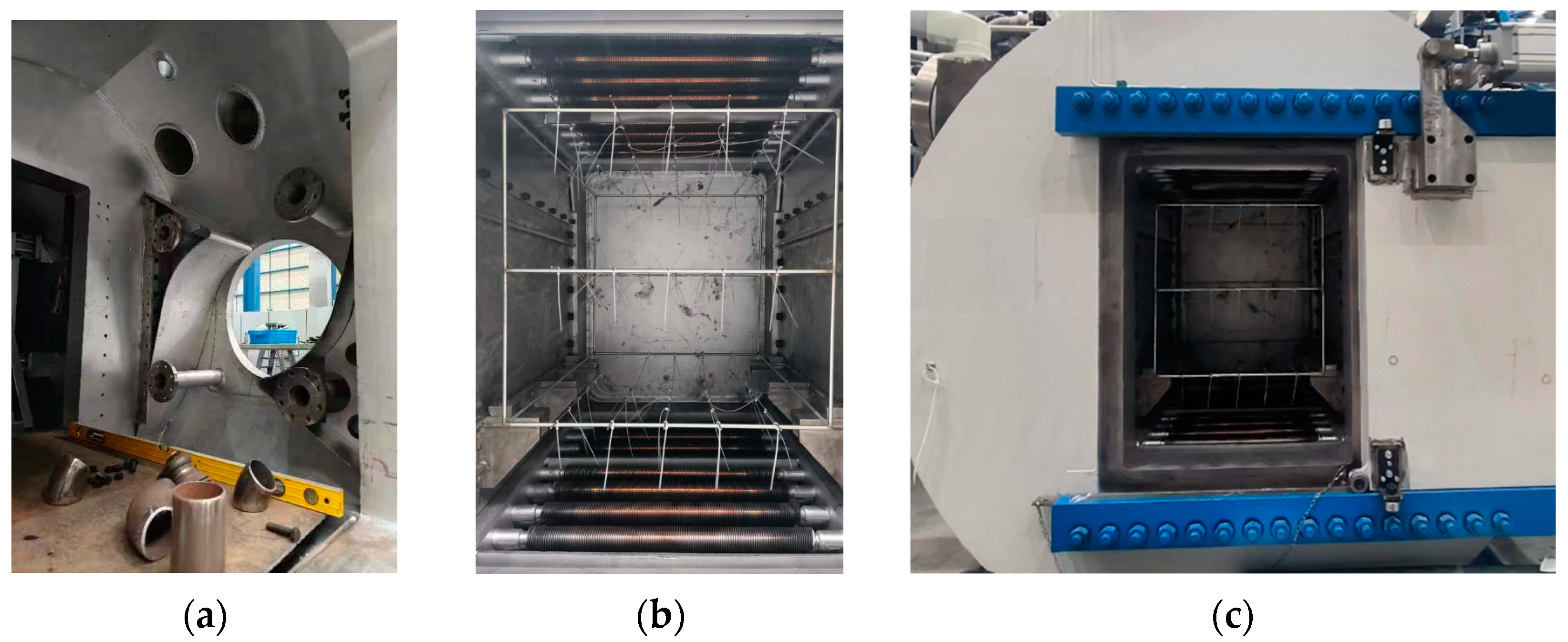
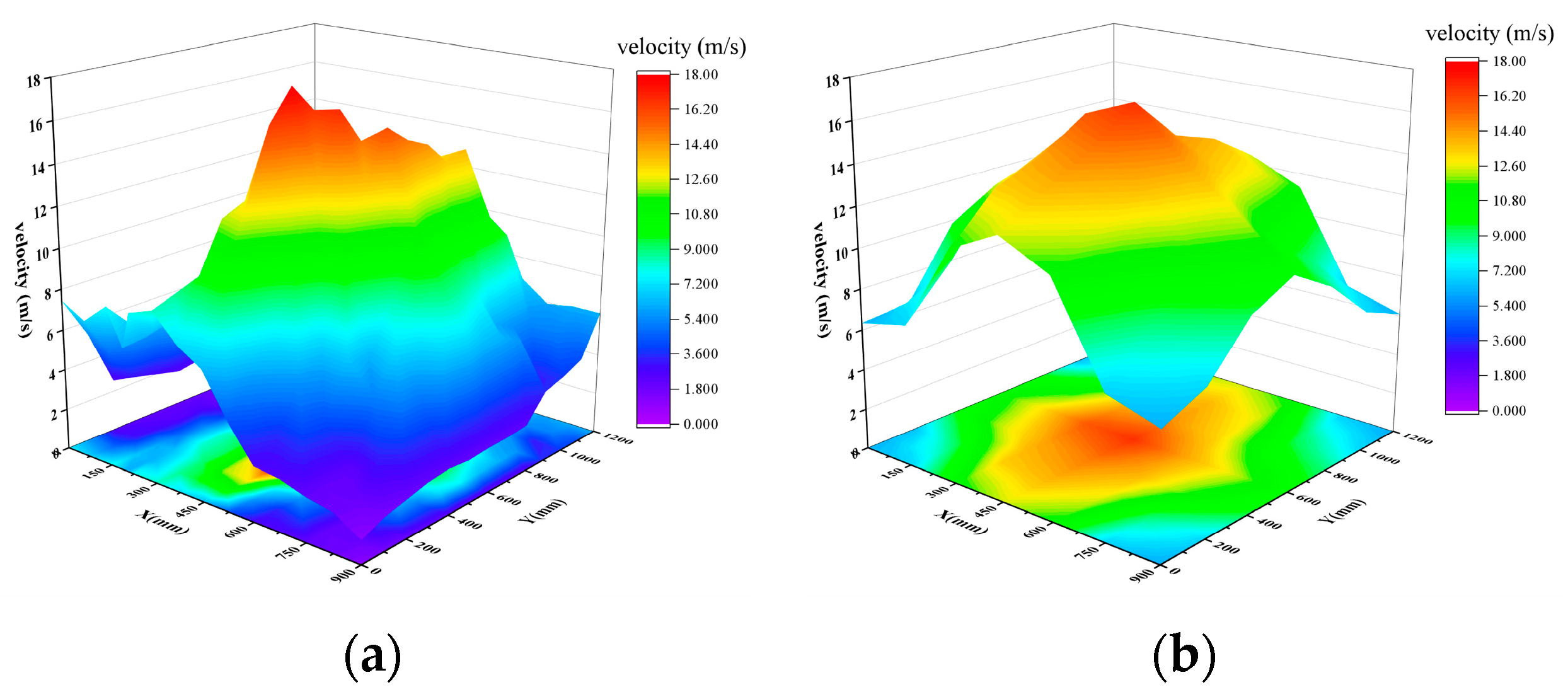
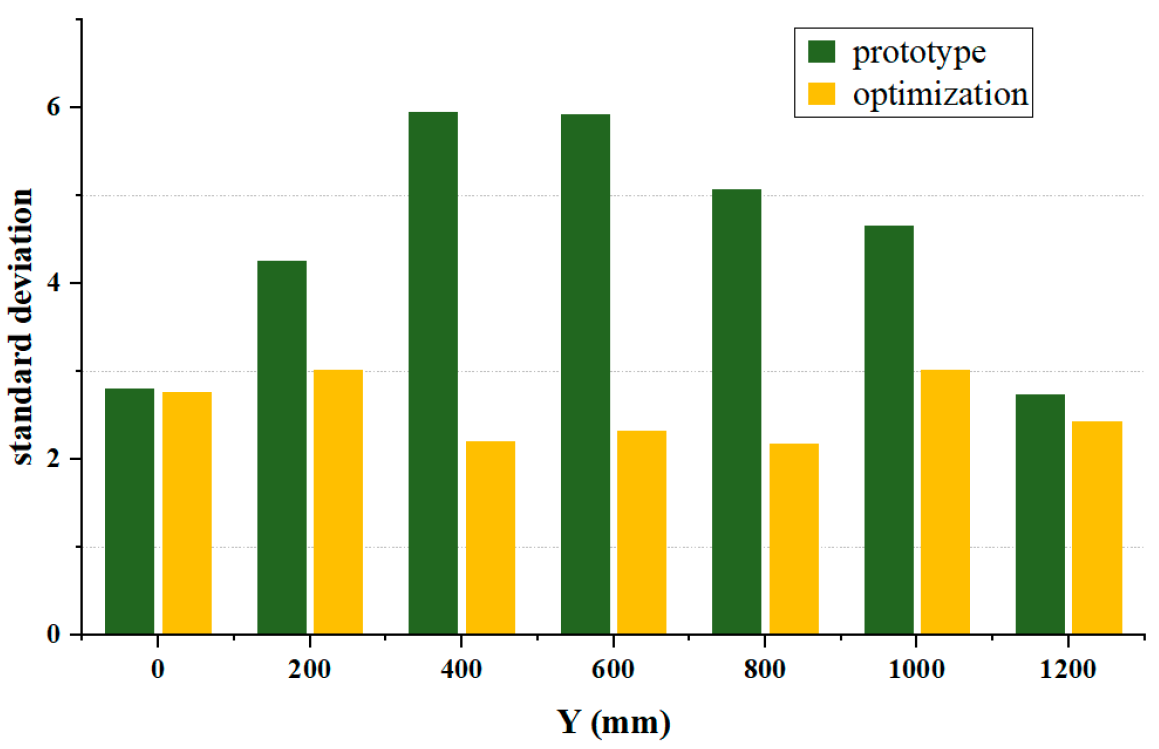
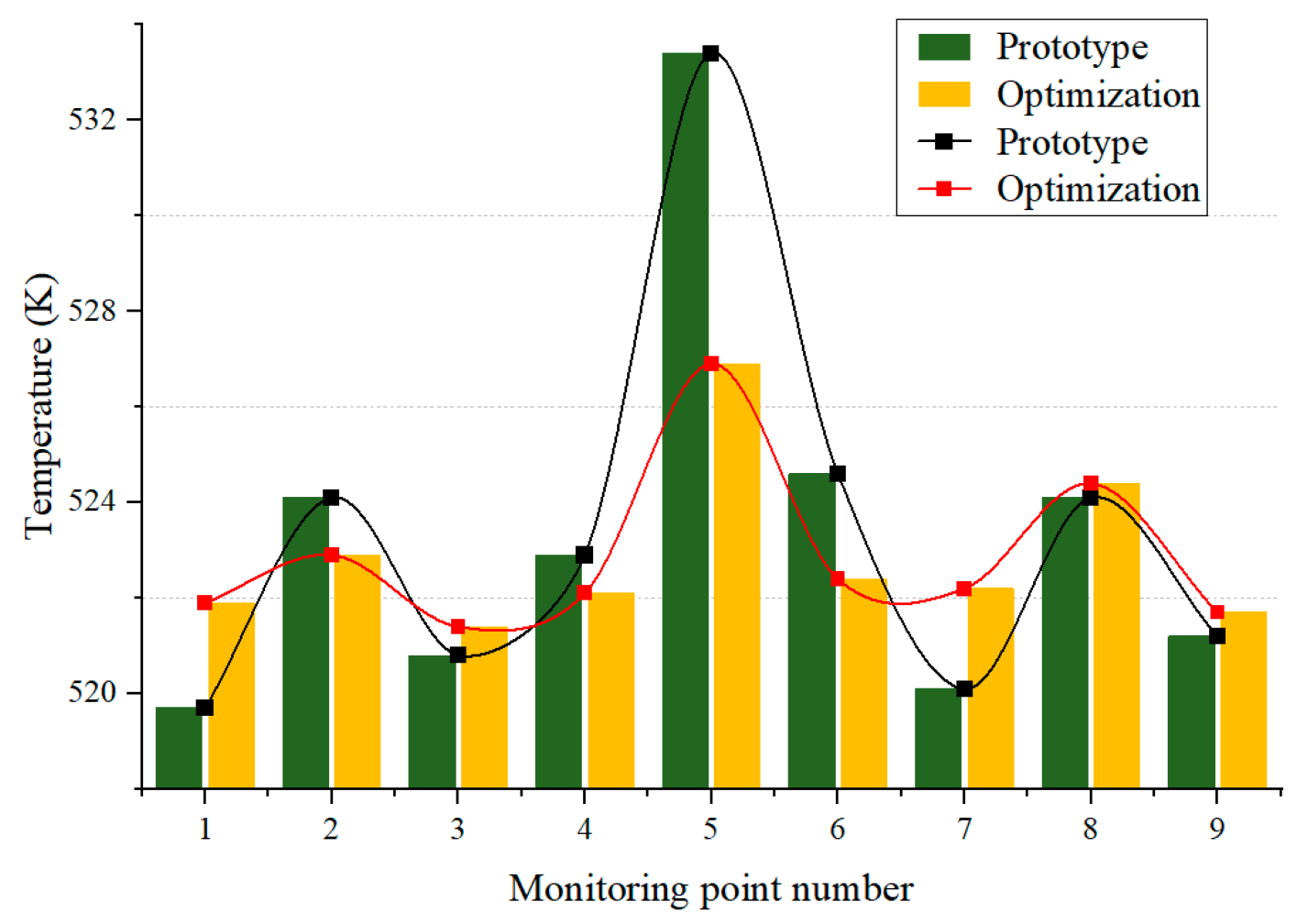
| Parameters | Value | Parameters | Value |
|---|---|---|---|
| Nominal speed n (r/min) | 3000 | Impeller suction diameter D1 (mm) | 354 |
| Nominal flow rate Qd (m3/h) | 14,500 | Impeller outlet diameter D2 (mm) | 520 |
| Nominal wind pressure (Pa) | 3200 | Impeller outlet width b1 (mm) | 145 |
| Work pressure (MPa) | 2.0 | Blade number Z | 10 |
| Number of finned tubes | 176 | Blade inlet angle β1 (°) | 13.7 |
| Blade thickness (mm) | 10 | Blade outlet angle β2 (°) | 36.0 |
| Volute height D3 (mm) | 1120 | Collector circle inlet diameter D4 (mm) | 520 |
| Inlet Domain | Outlet Domain | Volute Domain | Impeller Domain | Total |
|---|---|---|---|---|
| 1,308,411 | 1,207,765 | 3,019,409 | 4,529,117 | 10,064,702 |
Disclaimer/Publisher’s Note: The statements, opinions and data contained in all publications are solely those of the individual author(s) and contributor(s) and not of MDPI and/or the editor(s). MDPI and/or the editor(s) disclaim responsibility for any injury to people or property resulting from any ideas, methods, instructions or products referred to in the content. |
© 2025 by the authors. Licensee MDPI, Basel, Switzerland. This article is an open access article distributed under the terms and conditions of the Creative Commons Attribution (CC BY) license (https://creativecommons.org/licenses/by/4.0/).
Share and Cite
Zhou, S.; Wang, T.; Mao, Z.; Lu, L. Analysis and Optimization Design of Internal Flow Evolution of Large Centrifugal Fans Under Inlet Distortion Effects. Appl. Sci. 2025, 15, 3521. https://doi.org/10.3390/app15073521
Zhou S, Wang T, Mao Z, Lu L. Analysis and Optimization Design of Internal Flow Evolution of Large Centrifugal Fans Under Inlet Distortion Effects. Applied Sciences. 2025; 15(7):3521. https://doi.org/10.3390/app15073521
Chicago/Turabian StyleZhou, Shuiqing, Tianci Wang, Zijian Mao, and Laifa Lu. 2025. "Analysis and Optimization Design of Internal Flow Evolution of Large Centrifugal Fans Under Inlet Distortion Effects" Applied Sciences 15, no. 7: 3521. https://doi.org/10.3390/app15073521
APA StyleZhou, S., Wang, T., Mao, Z., & Lu, L. (2025). Analysis and Optimization Design of Internal Flow Evolution of Large Centrifugal Fans Under Inlet Distortion Effects. Applied Sciences, 15(7), 3521. https://doi.org/10.3390/app15073521





